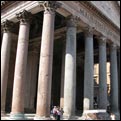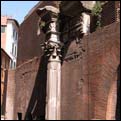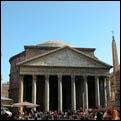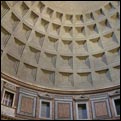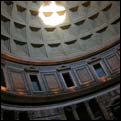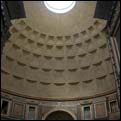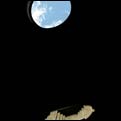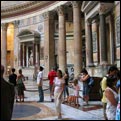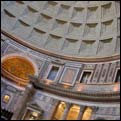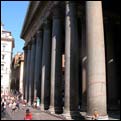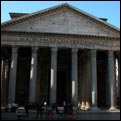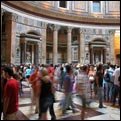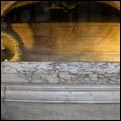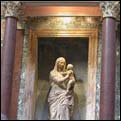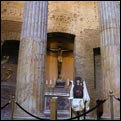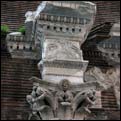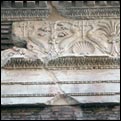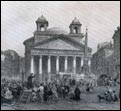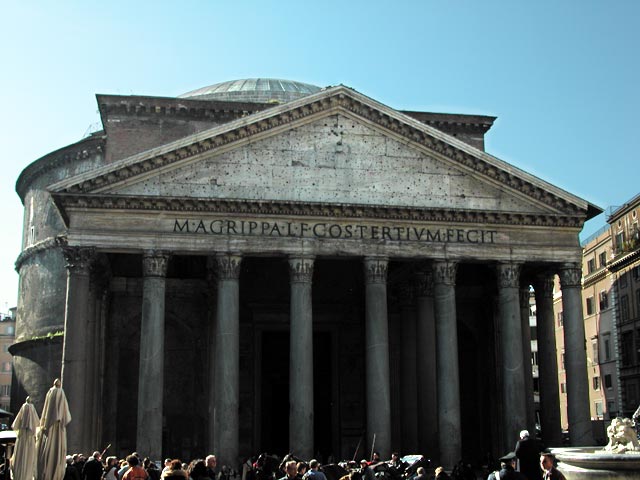
first part
The continuity of the life, of the political life of the City that is so well expressed by the Capitol is found too, in its religious aspect certainly, in the Pantheon, which, since the time of its foundation, has always been sacred to the gods, to the saints, those Divi Divinities, as both Pagans and Christians have agreed to call them. If we need, then, a witness to the continuity of the religious life of the City, of the slow and after all so gentle passing of Paganism into Christianity, in the hearts of men, at any rate, with many a strange and beautiful conservation of old things, old customs, old ways ofthinking, we shall find it best, perhaps, in the Pantheon. " There is nothing," says Horace, that the earth has hidden, but Time shall bring it forth into the sunshine"
Quicquid sub terra est in opricum proferet aetas ; defodiet condetque nitentia.
" and how many things now glittering it will bury and hide away." Though we may never see Agrippa's colonnade 1 of which he speaks, the Pantheon, which he built in 27 B.C., remains the most perfect ancient building in Rome, the only one, indeed, whose walls and arches have been completely preserved. Born in 63 B.C. and dead in 12 B.C. Agrippa was the friend and later the son-in-law of Augustus, as well as his general and minister. And as it seems, for the original purpose of the building is unknown, it was to the Julian House, the divine Caesar, that he built the Pantheon, that all-divine place which was one of the greatest monuments of the ancient City, built with all the solidity, boldness and splendour of the Roman genius, and remains one of the wonders of the world. A circular structure, 142 feet and 6 inches in height and diameter, its beautiful portico, formed by sixteen Corinthian columns 47 feet high, was 103 feet long. Of the columns, eight support a massive pediment, behind which rises another, still higher, set against the blind loggia which connects the portico with the dome. The other columns separate and divide the portico itself into three parts that of old were covered by vaults, and there beside the entrance are the two niches which once held the colossal statues of Augustus and Agrippa, the emperor and his friend. The tremendous walls of the rotunda, a perfect circle, are divided into two stories by ring courses, while above them springs the most wonderful thing in Rome, that cupola of concrete, of old covered over with tiles of gilded bronze, which was once the greatest dome in the world. The diameter is indeed the same as that of the building itself, the walls which support it being 19 feet in thickness. Divided into five circles of deeply sunk panels, twenty-eight in each circle, diminishing in size as they ascend, it is crowned with a crown of light 27 feet in diameter, which floods the whole sanctuary with its marvellous glory.
Within, the temple was lined with precious marbles, while in the seven niches that were set in its circumference stood, as we may suppose, the images of the gods, though only those of Mars and Venus, the deities of the Julian House, are known to have been there. The whole place was so spacious and wonderful that even in antiquity it was supposed to derive its name from heaven itself, lighted as it was by the sun or the moon, while round about the statues of gods were set those seven planets which ruled the destinies of men. It is no wonder that the applause which greeted Agrippa passed almost into a proverb, so that Horace would warn us against hoping for such praise : . scilicet utplausus quosfert Agrippaferas tu^ astuta ingtnuum vulpes imitata leomm, The Roman, save exceptionally, was not, one may think, a highly-cultured man; like the modern Englishman, he rather distrusted and despised the things of the mind, and left them to Greeks Ci 'ero makes Cato say that one of his great Romans, G. Flaminius, I think, multat etiam ut in homine Romano litterae. Littem was, of course, Greek literature and philosophy, of which he had " much for a Roman*&qu 't; There must have been, indeed there was, far more in Roman religion than one discerns on the surface, especially after its contact with Greek religion. For the very powerful influence of Greek thought is evident, not only in Roman religion but in Roman culture generally. In things of the mind, Rome was a province of Athens ; but whence did Virgil draw his deep religious sense, and how is it that Cicero so firmly, and even passionately, defends the belief in life after death and the immortality of the soul ? No one in antiquity, save S. Paul, has more eagerly defended a belief in a life hereafter. He even makes Cato greet the day of his death with : praeclarum diem . . . and says that this belief of his is the reason he can bear the greatest of misfortunes, the death of a beloved son, because he will certainly find him again after death. And then there is the famous Roman pietas. What, then, did the Roman mean by pietas, religio.fatum ? These words, with gravitas and simplicitas, might almost be said to express the Roman's conception of himself. It is difficult for us to appreciate a religion which had no creed, and was without a serious theology. Religio, however, according to Cicero, was a fundamental Roman characteristic, and means " attention ", a careful attention to, a being bound by, a manifestation of the divine. Its antithesis is neglegentia. Roman religion, at first just that attention, came perhaps to be a body of usages or ritual, not so much an attitude of mind as a rule of manners, before in the decline it fell into outrageous superstition.
Yet the men who built Rome, and even those who built the Empire, must have been of a Puritan sort, one thinks, durum genus, but continually attentive, all the same, to any suggestions of nature, from the stars to the flight of a bird, or the entrails of a sacrificial victim. And to-day the Pantheon is like a sudden revelation, as though in an unexpected moment we had come upon a legion of Caesar's army, or in the quiet sunlight, amid the ruins of the Forum, had heard the persistent voice of Cato in the Senate House : Delenda est Carthago. Yet it has suffered much from restoration, even in antiquity. It was first altered by Domitian, and then, struck by lightning in the time, of Trajan, it was restored by Hadrian, who, it seems, left only the portico altogether unchanged, and indeed it is to him rather than to Agrippa that we owe the whole of the present rotunda and the beautiful dome. Then in A.D. 202 Septimius Scvcrus and Caracalla had their way with it. So it remained in some sort a Temple of the Gods of all the gods, it seems, for the misunderstanding which has turned this " all divine" place into a temple "of All the Gods" began early till Phocas the tyrant, in the exile of the gods, presented it to Pope Boniface IV, who on May 13, 609, consecrated it, placing it under the protection of S. Mary of the Martyrs. So the Pantheon became S. Maria ad Martyres, and to ensure its sanctity the Pope caused to be buried there twentyeight wagon-loads of the bones of the martyrs brought hither from the catacombs. Then began the spoliation : as though after all one were not sure that the gods had indeed been turned out So Constans II, in 655, did not scruple to steal those precious tiles of gilded bronze for his palace in Constantinople. It was only with lead that Pope Gregory III covered the church some eighty years later, for the gods were humbler than of old, and, instead of our most precious posses* sions, demanded now but an humble and contrite heart. But it still kept about it some shadow of its ancient wonder and holiness, so that we find in the thirteenth century that every Senator was obliged to take an oath to defend it and preserve it for the Pope. Yet it was the Pope himself who did his best to destroy it, for Urban VIII took the brazen tubes on which the roof of the vestibule rested, to convert them into the twisted columns of the baldacchino of S. Peter - Quod non fecerunt Barbari, fecerunt Barberini, And if of old it excited the wonder and awe of the City, and in the Middle Age guarded the dust of the Martyrs, certainly then, more precious than silver or gold, it became the very model of the greatest buildings of that and a later time* The Baptistery of Florence was certainly meant to be as like it as might be ; it inspired the dome of S, Maria del Fiore, and Michelangelo swore to build it, as it were aloft, over S* Peter's, an oath which he contrived to keep ; while it was there that Raphael preferred to lie, with his betrothed beside him and his disciples at his feet,pursuing the dream of beauty which, as was said, had ravished him from our world, And yesterday, too, it was there that Italy laid her kings him who came down with gifts from Piedmont and him who fell by the dagger of Monza.
ROME BY EDWARD MUTTON

